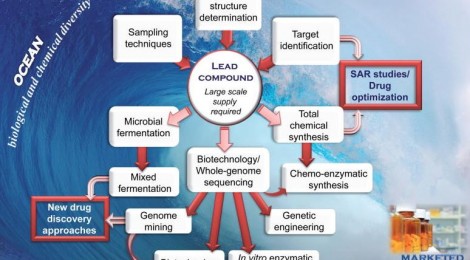
Marine Drug Discovery Becoming Major Research Venue
Ocean pastures offer an unsurpassed richness of biodiversity and incumbent natural drugs
The slippery slimy world of ocean pastures dominated by tiny plants and animals along with a plethora of bacteria, fungi, and virus is a soup of life of almost infinite complexity. Therein the rich soup life is a constant struggle and chemical defense is just about the only advantage an organism will find of use. The National Institute of Health is betting that this living ocean petri dish will deliver the pharmaceuticals of the future.
This largely unexplored marine world that harbours the most biodiversity may be the vastest resource to discover novel ‘validated’ structures with novel modes of action that cover biologically relevant chemical space. Several challenges, including the supply problem and target identification, need to be met for successful drug development of these often complex molecules; however, approaches are available to overcome the hurdles.
Advances in technologies such as sampling strategies, nanoscale NMR for structure determination, total chemical synthesis, fermentation and biotechnology are all crucial to the success of marine natural products as drug leads. We illustrate the high degree of innovation in the field of marine natural products, which in our view will lead to a new wave of drugs that flow into the market and pharmacies in the future.
The role of natural products as a source for remedies has been recognized since ancient times. Despite major scientific and technological progress in combinatorial chemistry, drugs derived from natural product still make an enormous contribution to drug discovery today. Nature is an attractive source of new therapeutic candidate compounds since a tremendous chemical diversity is found in millions of species of plants, animals, marine organisms and microorganisms.
Microorganisms such as bacteria and fungi have been invaluable to discover drugs and lead compounds. These microorganisms produce a large variety of antimicrobial agents which have evolved to give their hosts an advantage over their competitors in the microbiological world. The screening of microorganisms became highly popular after the discovery of penicillin but in recent years the list of antibacterial agents (bacteria- or fungi-derived) has increased considerably with the arrival of cephalosporins, tetracyclines, aminoglycosides, rifamycins, and chloramphenicol.
Although most of the drugs derived from microorganisms are used in antibacterial therapy, some microbial metabolites have provided lead compounds in other fields of medicine. For example: the fungal metabolite lovastatin, which was the lead compound for a series of drugs that lower cholesterol levels, the ciclosporin (fungal metabolite) currently used to suppress the immune response after transplantation operations and sirolimus- a bacterium-derived macrolide- used in the treatment of some cancers.
You can read a good collection of papers on the rapidly developing marine drug discovery world on the NIH Pub Med site. The link below is to just one of the informative papers that can be found there. It is a good starting point.
Marine natural products: a new wave of drugs?
http://www.ncbi.nlm.nih.gov/pmc/articles/PMC3210699/pdf/nihms327344.pdf









Comments are closed, but trackbacks and pingbacks are open.